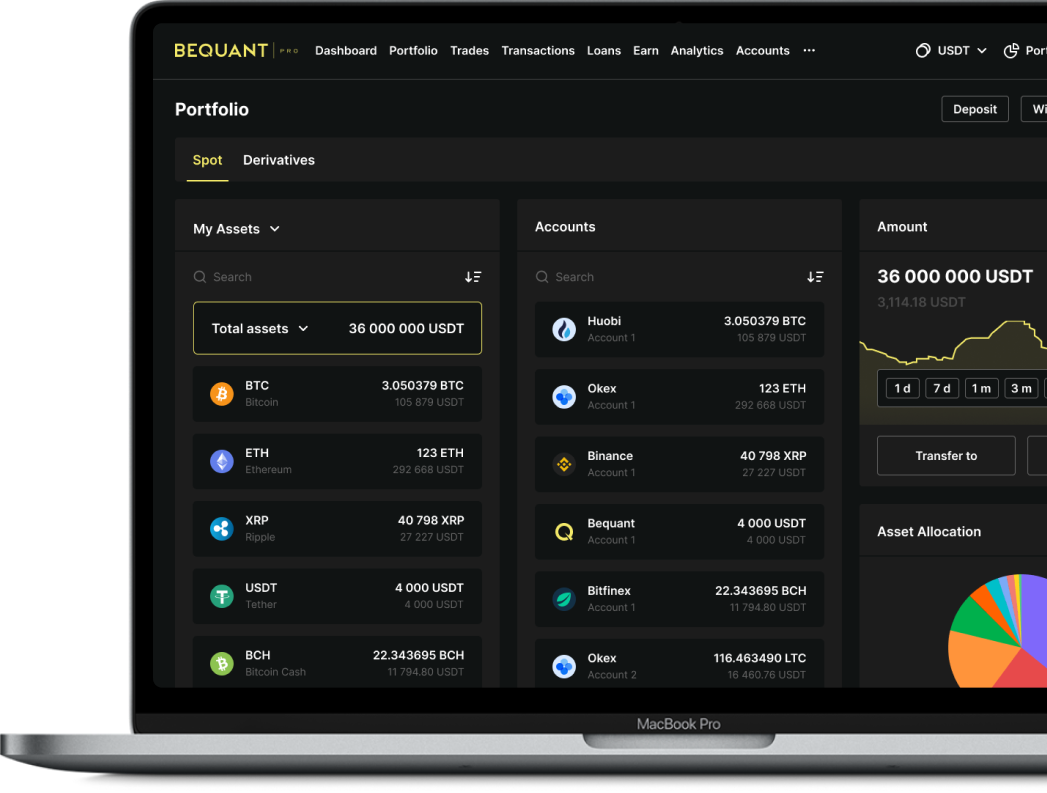Latin Moves

Summary:
As the US Fed continues its dance with the markets, our glance turns south to a region that has historically struggled with political uncertainty, indebtedness, runaway inflation and low investment. The rollout of Strike’s payment app to Argentina should be welcome in a country with +50% inflation, a 100% wedge between the real and unofficial exchange rate and no signs of an IMF agreement. The region should return to its low growth trajectory with inflation easing but at still high levels, making it a perfect fit for digital assets, as we are seeing with the Rio government purchase of BTC. In DeFi, there is a lot of positive action in the up and coming Layer 1’s such as Fantom and Near, which we cover in depth, as well as a primer on the ETH Beacon Chain ahead of the planned merge. Finally sticking to the Latin theme, unicorn Mercado Bitcoin of Brazil, has gained a foothold in Portugal from which to launch a European incursion.
Macro
FED FRETS OVER TIGHT LABOR MARKET
Fed Chairman Jerome Powell in congressional testimony said he was optimistic supply-chain issues would ease and help bring inflation down. However, he also noted that the smaller U.S. labor force “can be an issue going forward for inflation, probably more so than these supply-chain issues,” as the December job report signalled unemployment falling to 3.9% from 4.2% in November. Wages were up 4.7% YoY, but this was not enough to offset 7% inflation. Brainard continued the anti-inflation tone at her confirmation hearing as second in command at the Fed, while member Barnard said four hikes may be in order.
Gains in energy prices—which had been driven by pandemic disruptions as well as by weather and geopolitics—showed signs of slowing, with gasoline prices falling 0.5% in December from November. However, food inflation rose 0.5% in December from November.
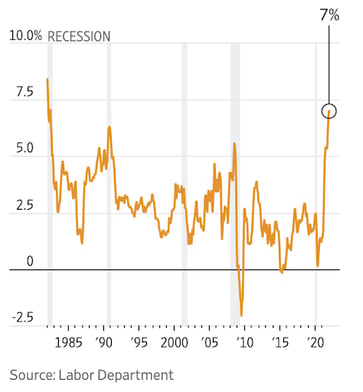
As we stated previously, the December survey of manufacturers by the Institute for Supply Management showed a decline in prices and delivery times, signalling that materials shortages might be easing.
Consumer price inflation in the US rose 7% year over year. We should be nearing YoY highs as some comps get easier, PPI rose below expectations +0.2% vs. 0.4%e mom seasonally adjusted (9.7% YoY). Retail sales fell 1.9%.
CPI data for December showed the official measure rising by 7%, and should be near the highs
Crypto
TROPICALIZING CRYPTO
This week, Strike, the Lightning Network payment app, rolled out its functionalities in Argentina, a country riddled by 50% plus inflation, deeply negative real rates and capital controls and announced it would also introduce its services in Brazil and Colombia. Argentines will be able to make bitcoin remittance payments, receive bitcoin tips on Twitter and use Strike's peer-to-peer transaction services.
El Salvador was just the toe in the water and given an outlook of low growth and high inflation in many of these countries, it seems an opportune time to enter the region. The local Rio de Janeiro government also divulged a 1% BTC holding. In Argentina, specifically, the heavily managed currency should continue to devalue, with the difference between the official and the unofficial rate at over 100%. The IMF and the Fernandez government did not begin negotiations this year on the right footing, with the administration vying for back-loaded fiscal consolidation while the IMF is pushing for it to be font-loaded. Unsurprisingly, Chainalysis found that Argentina is one of the top ten countries in the world for crypto adoption.
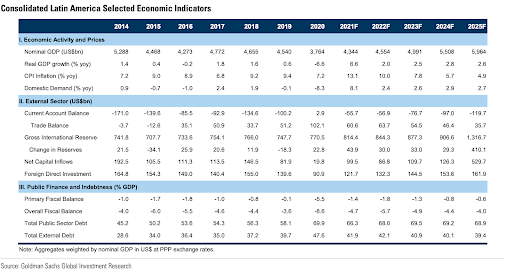
RECORD HIGH BTC OPEN INTEREST W/NEGATIVE FUNDING RATES LED BY BINANCE
As per Glassnode, futures perpetual open interest of BTC reached new all-time highs of 264k BTC this week as the price declined, rising +42% since December 4 and surpassing the previous high of 258k BTC in November. Leading the rapid growth of futures speculation are leveraged players on Binance. The exchange has the lion’s of share of futures open interest, which has risen by several percentage points over the last few weeks, to 30%. Though open interest is high, futures volume peaked in the first half of 2021, at over $75 bn per day, it now sits at $38bn, similar to last year’s summer lows. This lower liquidity can exacerbate moves.
Bitcoin open interest at record high in BTC terms

Futures open interest at almost 2% of market cap can trigger margin flushes
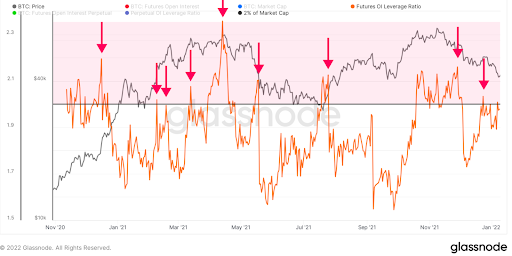
In these bearish conditions, we can see coins ageing at a higher rate than spending as higher conviction holders hang on to their coins. Following a brief period of net spending after the early November price peak, maturation has again risen.
BITCOIN AS A PORTFOLIO DIVERSIFIER
Fidelity Investments Canada, the country’s first regulated institutional bitcoin custodian, added bitcoin to two of its All-in-One exchange-traded funds, ETFs that provide investors with exposure to different assets, regions, market capitalizations, and investment styles. The addition will change the funds’ risk ratings to medium from low and should provide better risk-adjusted returns to a classic 60% equities/40% fixed income portfolio and a higher risk one that has an 85%/15% mix. In future, this should become the standard as mainstream investors incorporate digital assets into their portfolios.
PAYPAL STABLECOINS?
PayPal has confirmed that it is exploring a stablecoin backed by US dollars, according to Bloomberg. The timing could work well as we are expecting US regulators to focus on stablecoins in 2022 after the President’s Working Group report was published last December and the Fed’s report is due any day. The company added crypto payments and the ability to hold crypto in 2020 to its service as well as to Venmo.
ROBINHOOD ON THE SIDELINES
The retail-trading platform said it doesn’t plan on spending significant amounts of corporate cash on crypto, said the CFO at a summit this week. Robinhood reported $51 million in revenue from crypto trades during its latest quarter, and held about $6.16 billion in cash and cash equivalents at the end of September, up from $1.40 billion at the end of 2020. Jason Warnick also said Robinhood is keeping an eye out for comments from regulators on how to treat crypto assets and hence why it hasn’t added any new coins or currencies in addition to the ones it already offers. Proof that regulatory uncertainty is keeping the industry in a holding pattern.
BITCOIN MINERS ARE STILL ACCUMULATING
Bitfarms has added 1,000 BTC to its bitcoin holdings, with the total outlay costing $43.2 million. They now have 4,300 BTC in line with acquisitions over the last two quarters, while North American miners now hold over $1bn in BTC.
DORSEY BACKS DEVELOPER FUND
Former Twitter boss Jack Dorsey is helping to launch a new non-profit fund that will help defend Bitcoin developers against litigation by appointing defense counsels and paying legal bills. The first case will be the developers who are being sued by Tulip Trading Ltd over allegedly billions of dollars of lost funds from the now defunct Mt. Gox exchange. Craig Wright, the entrepreneur behind Tulip Trading, also claims that he is the creator of Bitcoin, Satoshi Nakamoto, and therefore has a copyright claim to the white paper.
TP ICAP LAUNCHES CRYPTO ETPS
The world's biggest inter-dealer broker TP ICAP Has launched crypto-related exchange-traded products (ETPs) for its European clients. In the coming months, the company will look to expand to offer ETFs in the US. In the second quarter, ICAP will launch a spot trading platform, which will allow customers to trade physical bitcoin for the first time, with external custodians to clear and settle the product. It is also looking into OTC derivatives.
ETHEREUM UPGRADE AND THE BEACON CHAIN
In 2015, Ethereum initially launched with a proof-of-work (PoW) consensus mechanism, but the vision for its blockchain has always been to become an energy-efficient proof-of-stake (PoS) network. Ethereum developers have created different PoS consensus algorithms for Ethereum 2.0 and finally settled on Casper in 2017.
But, a fundamental question remained: How to upgrade the core of a decentralised running system without halting it? The solution is the so-called beacon chain. The beacon chain is a fully independent network that runs on a PoS consensus mechanism in parallel with the Ethereum PoW mainnet. In this way, the beacon chain is perfected and tested before being shipped to replace the old PoW model, without affecting all currently running Dapps on Ethereum. For context, the beacon chain launched in December 2020, and as of today, has over 280.000 validators and over 9 million ETH (approx US$30bn) staked to secure the network.
ETH staked by entity: the top four accounts are almost 50% of all staking on ETH 2.0 Beacon Chain, with Lido as a newcomer
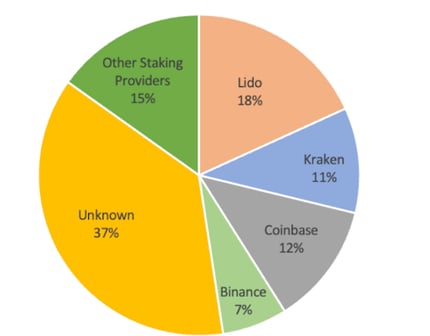
Source: CoinDesk, Nansen
In order to realise a successful transition, it is important that the past transactions history is preserved when replacing the old PoW with the new PoS consensus layer. It will be accomplished through ‘The Merge’. Once The Merge is completed, the consensus on the Ethereum blockchain will be achieved through the new PoS mechanism, therefore eliminating the old PoW without affecting the old history of the blockchain. In other words, The Merge allows the upgrade of the Ethereum consensus layer without affecting its data layer.
In the new proof-of-stake (PoS) mechanism, to guarantee the security of the network, anyone with 32 ETH can become a validator and participate in the network’s consensus algorithm (the more Ethereum one deposits, the more validator slots one gets). Each block requires ⅔ of all active validations to be finalized. If a malicious actor tries to defraud the network (finalized block reversion) by setting up a large number of nodes, a portion of their funds is seized by the protocol. This rule makes attacks to the network very expensive and economically unfeasible. The advantage with respect to PoW is that PoS does not require the same amount of energy to keep the network secure. Unofficial estimates have calculated that the energy savings coming from the switch from PoW to PoS will be close to 98%.
Another major motivation for the switch to proof-of-stake is increased decentralization and censorship resistance. PoS allows more participants to join a network as the entry barriers, such as technical knowledge and upfront investments are lower when compared to PoW. Moreover, anyone can pool their ETH and stake anywhere in the world, while PoW is constrained by the price of the electricity in each specific country or territory and requires significant hardware investments.
The Merge is expected to happen in 2022, but no hard deadlines have been set by developers yet.
DeFi / NFTs / Metaverse
DEX VOLUMES RECOVERED AT THE END OF 2021
Kaiko reported that trade volumes on Ethereum-based decentralized exchanges have been recovering since July, totalling $75 bn in the last month of 2021. 77% of that volume was on Uniswap 3, which has been a success since its inception. Uniswap V3 was launched last spring to resounding success. It offers up to 4k times better capital efficiency and higher returns. Concentrated liquidity offers liquidity providers increased control over price ranges. Those positions are then aggregated together into one pool, allowing users to trade against one combined curve. Multiple fee tiers allow liquidity providers to be more fairly compensated for the level of risk they take on.
Curve, the automated platform for stablecoin trading, saw activity rise from $3 bn to $4 bn. As we reported last week, Total Value Locked (TVL) of over $40 bn on Curve and Convex Finance dominate the blockchain given the liquidity incentives provided to stake and have a say in the pools that receive rewards.
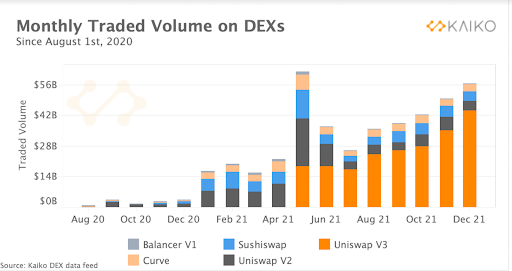
THE FOAN TRADE (Fantom,One Atom, Near)
This week as the market staged a slight recovery, the action has been in altcoins once again with Terra, Near, FTX, Fantom, Harmony, and Convex as particular standouts, posting double-digit returns.
NEAR benefitted from $150 mn in funding from Alameda Research, Andreessen Horowitz, and Three Arrows Capital, while 21Shares announced an ETP based on the Terra blockchain. Fantom rose in anticipation of a new DeFi product, with details TBA. Harmony saw the rise of DeFi Kingdom, an integrated game, exchange and NFT project that’s locked over $740 million worth of its token, JEWEL, and other assets since its launch.

FANTOM FANFARE
Devs Andre Cronje and Daniele Sestagalli announced a new Automated Market Maker (AMM) DeFi product on the Fantom blockchain, known as ve (3,3)/SOLID. The supply will be airdropped to Fantom protocol holders this week or next. Anticipation of the product, as well as high 30%-60% APR yields on stable coins drove more than 1 million transactions on the Fantom network, compared with 728,000 transactions on Avalanche last week, according to Delphi Digital. Such transactional activity on Fantom was previously seen in September of 2021.

Source: Etherescan.io, Snowtrace.io
COSMOS IS VIEWED AS A TOP INTEROP SOLUTION
Much like the universe, the Cosmos ecosystem is expanding. ATOM is up 85% over the last 30 days thanks to the integration between its DEX and the inter blockchain communication protocol, which seeks to solve the problem of interoperability between blockchains as well as scalability, cost and environmental footprint. Another factor is the launch of Evmos, an application-agnostic chain which allows Ethereum-based assets and projects to move easily within the Cosmos network. Previously, there were no interconnections between Ethereum and Cosmos.The network’s expansion to 28 interconnected chains with a total value of roughly $68 billion like Binance Smart Chain (BSC), Terra (LUNA) and Crypto.com (CRO) are also helping. Finally, the Theta upgrade scheduled for March 31 could be a catalyst as new features such as meta transactions and liquid staking will be added.
DYDX TO DECENTRALIZE
DydX, the top derivatives exchange published a roadmap for 2022 when it will focus on making the platform entirely decentralized. The exchange’s volumes spiked last year but have since retreated.
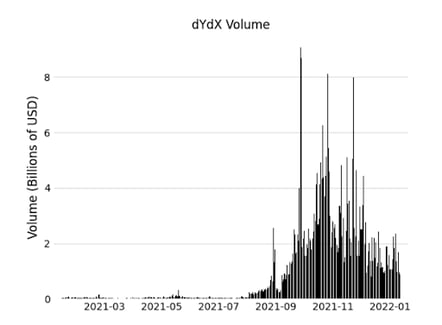
SOLANA’S SERUM PROTOCOL RAISES UP TO $100 MN
The Incentive Ecosystem Foundation (IEF), a community-led organization focused on supporting the Serum network, has raised over $70 million and is in the process of closing the round at $100 million, according to Blockworks. Serum is a dex and liquidity provider for DeFi protocols on Solana’s blockchain. It is the eighth-largest dex and has a 24-hour trading volume of about $273 mn according to CoinGecko. Around 85% of the allocation that investors receive will go into current and future tokens including Serum, Solana and other ecosystem tokens like Raydium. The aim is to expand into the traditional finance space.
DEFI YIELDS FOR MERCHANTS
Elrond, an Ethereum competitor claiming up to 100,000 transactions per second, is acquiring Utrust, a Portugal-based cryptocurrency payments firm. The terms of the deal were not disclosed. Both platforms have tokens, and the firms said the combined community will be updated early this year on the final mechanics of the deal from a tokenholder perspective. Allowing online payments to take advantage of Web 3, the next generation of the internet built around dapps is their goal, allowing merchants to access DeFi and staking via “Merchant Yield”. At the moment, merchants are charged between 3% and 11% per transaction by payment processors.
HEY, BIG SPENDER. VAMPIRE ATTACK ON OPENSEA
A new NFT platform called LooksRare went live this week, as more marketplaces try to take on hugely successful platform OpenSea. LooksRare is a community-focused marketplace that says it will develop new features based on what its users want. LooksRare was launched with a vampire attack (to poach users with its tokens) using its LOOKS coin to reward big spenders who have traded more than 3 ETH on OpenSea. The marketplace charges a 2% fee on all trades, which are distributed to those staking LOOKS tokens. The token has amassed $400 mn in sales in a few days.
Regulation
IS IT HERE YET? THE FED’S STABLECOIN REPORT IS IMMINENT
Chairman of the Federal Reserve Jerome Powell has assured Congress at this week’s hearing that the Fed's much-anticipated report on cryptocurrencies will be out within weeks. However, it seems from his statements that this will be an ongoing consultation process rather than a definitive answer for the space. Powell explained, “it’s more going to be an exercise in asking questions and seeking answers from the public.” The report is expected to focus on the outlook for a central bank digital currency.
Investment Tracker
- Softbank-backed Brazilian company 2TM, the firm behind Mercado Bitcoin, Latin America’s largest crypto exchange, is acquiring a controlling stake in Lisbon-based crypto exchange CriptoLoja. The Brazilian firm, valued at $2.2 billion, did not divulge the terms of the acquisition, but said the transaction is pending approval with Banco de Portugal. This will provide a good base from which to gain a foothold into the European market, starting with OTC operations before moving into the retail and institutional markets.
- A community-led foundation of Project Serum has raised $75 million in a token sale. Tiger Global, Commonwealth Asset Management, and other investors were offered several tokens at a discount, including SOL and SRM, the token of the Solana-based dex.
- Katie Haun, who is stepping down as partner at Andreessen Horowitz (a16z) to start her own venture capital firm, is looking to raise $900 million for two crypto investment funds, according to the Financial Times. She is seeking $300 mn for a crypto startup fund and $600 mn for larger companies and digital tokens. She had recently helped raise $2.2 bn for her previous firm.
- Coinbase said it is buying a regulated crypto futures exchange, FairX, as part of a move to offer crypto derivatives to traders in the United States. Derivatives account for over half of volumes, with $2.9 trillion in December, as per CryptoCompare.
- The Near Foundation, the group of developers behind the blockchain, announced a $150 million private token funding round led by Three Arrows Capital.
- DeFi Alliance, the incubator of platforms ranging from Sushi to Olympus DAO, changed its name to “Alliance DAO” Thursday after a $50 million raise. Some 300 contributors provided funding for the “digital startup nation.”
Until next week!
Disclaimer: The views expressed in this newsletter are my own and not intended as financial advice or a recommendation, but only for informational purposes. You should carry out your own independent research or consult a financial adviser if you are unsure. Please also be advised that I hold investments in some of the assets mentioned in this report, including digital assets, equities and ETFs.
